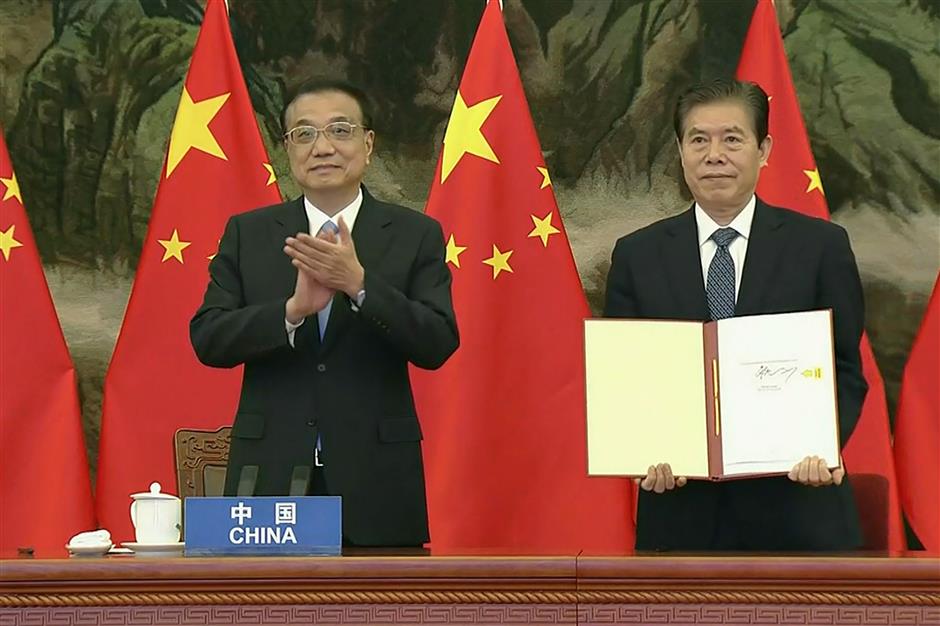Asia-Pacific countries launch world's biggest free trade bloc with RCEP deal signed

Vietnamese Prime Minister Nguyen Xuan Phuc addresses the signing ceremony of the Regional Comprehensive Economic Partnership (RCEP) during the 37th ASEAN Summit and related summits via video conferences in Hanoi, Vietnam, Nov. 15, 2020.
China and 14 other countries agreed yesterday to set up the world’s largest trading bloc, encompassing nearly a third of all economic activity, in a deal many in Asia are hoping will help hasten a recovery from the shocks of the pandemic.
The Regional Comprehensive Economic Partnership, or RCEP, was signed virtually yesterday on the sidelines of the annual summit of the 10-nation Association of Southeast Asian Nations.
“I am delighted to say that after eight years of hard work, as of today, we have officially brought RCEP negotiations to a conclusion for signing,” said host country Vietnam’s Prime Minister Nguyen Xuan Phuc.
“The conclusion of RCEP negotiation, the largest free trade agreement in the world, will send a strong message that affirms ASEAN’s leading role in supporting the multilateral trading system, creating a new trading structure in the region, enabling sustainable trade facilitation, revitalizing the supply chains disrupted by COVID-19 and assisting the post pandemic recovery,” Phuc said.
The accord will take already low tariffs on trade between member countries still lower, over time. Apart from the 10-member Association of Southeast Asian Nations, it includes China, Japan, South Korea, Australia and New Zealand.
Officials said the accord leaves the door open for India, which dropped out in November last year due to domestic opposition to its market-opening requirements, to rejoin the bloc.
The United States is absent from both RCEP and the successor to the Obama-led Trans-Pacific Partnership, leaving the world’s biggest economy out of two trade groups that span the fastest-growing region on earth.
The RCEP agreement “is an unprecedented mega regional trading arrangement that comprises a diverse mix of developed, developing and least developed economies of the region,” leaders of the participating countries said in a joint statement at the fourth RCEP summit prior to the signing ceremony.
“It would cover a market of 2.2 billion people, or almost 30 percent of the world’s population, with a combined GDP of US$26.2 trillion or about 30 percent of global GDP, and accounts for nearly 28 percent of global trade (based on 2019 figures).”
The RCEP “represents an important step forward toward an ideal framework of global trade and investment rules,” they said.
RCEP “will help reduce or remove tariffs on industrial and agricultural products and set out rules for data transmission,” said Luong Hoang Thai, head of the Multilateral Trade Policy Department at Vietnam’s Ministry of Industry and Trade.
The pact will take effect once enough participating countries ratify the agreement domestically within the next two years, Indonesia’s trade minister said last week.

Chinese Premier Li Keqiang claps as China’s Commerce Minister Zhong Shan holds up the Regional Comprehensive Economic Partnership agreement during the signing ceremony yesterday.
Chinese Premier Li Keqiang hailed the agreement as a victory against protectionism.
“The signing of the RCEP is not only a landmark achievement of East Asian regional cooperation, but also a victory of multilateralism and free trade,” Li said.
With the largest participating population in the world, the most diverse membership and the greatest development potential, the free trade bloc will definitely inject new impetus into regional development and prosperity, and contribute to global economic recovery and growth, Li said.
Li said that after eight years of negotiations, the signing of the RCEP has brought light and hope to people amid the current grim international situation, showing that multilateralism and free trade remain the correct direction for the world economy and human progress.
The RCEP allows people to choose solidarity and cooperation when facing challenges, instead of resorting to conflict and confrontation; and to choose mutual assistance and support, rather than taking a “beggar-thy-neighbor” approach or a “wait-and-see” attitude, he said, adding it shows the world that opening-up and cooperation are the only way to achieve mutually beneficial outcomes.
China’s finance ministry said the new bloc’s promises include eliminating some tariffs within the group, including some immediately and others over 10 years. “For the first time, China and Japan reached a bilateral tariff reduction arrangement, achieving a historic breakthrough,” the ministry said in a statement. The deal marks the first time China, Japan and South Korea have been in a single free trade agreement.
Japanese Prime Minister Yoshihide Suga said he would firmly convey his government’s support for “broadening a free and fair economic zone, including a possibility of India’s future return to the deal, and hope to gain support from the other countries.”
The RCEP is “a hugely symbolically significant agreement, coming at a time of global trade uncertainty,” said Australian Minister for Trade, Tourism and Investment Simon Birmingham.
“It says in a really powerful and tangible way that our region, which has been the driver of global economic growth, is still committed to the principles of trade, openness and ambition,” he told the Australian media yesterday.















